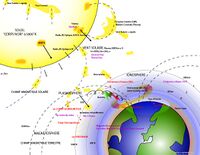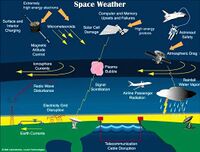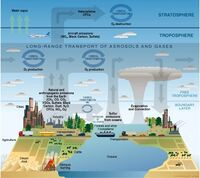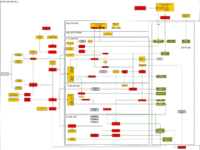Environmental Systemic Risks
Sommaire
Biological stress factors, environmental risks
The first version of this article was made in 2004/2005, the interdiscipline called "Earth System Science" was still in the making, it only appeared on Wikipedia in 2009.
On an international scale, setting up programs to set up indicators, map and monitor all the systemic risks that could weigh on the planetary environment will appear - more and more - as a major priority.
It is interesting to note that these risks - over the years - are gradually taken into account, especially where long-term societal and economic issues are observed (World Forum, UN).
Direct measures of biodiversity
Biodiversity responds to the pressure that the environment exerts on living beings. The measurement of this biodiversity indirectly makes it possible to measure biological stress.
In the current state of knowledge and means of measurement, it seems difficult to assess biodiversity on the scale of entire regions: this cannot be envisaged other than locally. There are a few methods for this:
- Abundance biomass comparison method (ABC): calculation of the level of disturbance (Clarke and Warwick, 2001a)
- Shannon or Shannon-Wiener (H') diversity index (Pohle et al. 2001)
- Species abundance curve
- Average taxonomic distance (AvTD) and variation in taxonomic distance (VarTD) (after Clarke and Warwick, 2001b): their average values are independent of the sampling effort: the response to increasing environmental stress is monotonic (i.e. it decreases or increases with the level of disturbance)
Biodiversity responds to the environment and the pressure it exerts; if such that within the framework of this study we are interested precisely in what disturbs this biodiversity, it is not necessarily useful to measure it directly, but rather to be interested in the pressures which the environment exerts.
This is assessed by listing the sources of biological stress.
Biological stress
It is expressed by attacks on the environment, it promotes the development of certain species to the detriment of many others. A "stressed" ecosystem will respond by an impoverishment in the absolute number of species to the benefit of a few that will occupy the most affected or even disappeared ecological niches.
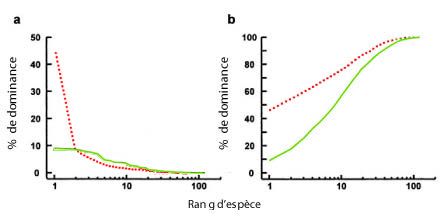
"abundance": % of individuals of species i
"biomass": % of the biomass represented by species i
Environmental Vulnerability Index (IVE)
Drawing up a list of vulnerabilities is a task that should increasingly preoccupy future generations, all the more so as they will increasingly be confronted with global climate change.
For example, the Environmental Vulnerability Index (EVI) is a measure that was devised by the South Pacific Applied Geosciences Commission (SOPAC), the United Nations Environment Program to characterize the relative severity of various types of problems environmental conditions suffered. EVI results are used to focus on planned solutions to negative pressures on the environment, while promoting sustainability.
These vulnerabilities are articulated according to a logic in 3 levels (cf, following chapter):
- Original environmental system(s)
- Disturbing natural or man-made factors (stress)
- measurable indicators
- Disturbing natural or man-made factors (stress)
Also see Environmental Vulnerability Index on Wikipedia.
Examples of stressors
- climatic phenomena,
- Rainfall,
- Droughts,
- amount of heat,
- Storms,
- Gels,
- Pollution,
- boreholes,
- Acid rain,
- Mutagenic elements, electromagnetic radiation ,
- Change in dissolved oxygen concentration,
- Fires,
- Biological balances,
- Nutrient content in food,
- Geological phenomena,
- Volcanic eruptions,
- Avalanches,
- Landslides, ...
Examples of measured variables
In any case, from these environmental factors, it is a question of finding measurable indicators and managing to identify the most important factors. It is necessary that these are measured over sufficiently long durations to be considered "relevant/critical". For example:
- Modification of the ph level,
- Sulphate concentration (SO4/SO2),
- Concentration of phosphorus / Phosphates (P/PO4),
- Nitrogen concentration (N/NO3),
- Vertical and horizontal concentration of ozone (O3),
- Active radiation for photosynthesis,
- Air temperature at the surface of the oceans (by satellite),
- Measurement of chlorophyll concentrations,
- Concentrations of dust in the atmosphere,
- CO2 rate, ...
Classification of Environmental Systems
We can classify environmental risks according to their environmental sphere of origin. On U-Sphere this division was made:
- The Heliosphere, the Magnetosphere,
- Atmosphere,
- The Litosphere,
- The Hydrosphere, Cryosphere,
- The "Cosmosphere",
- The Anthroposphere
Cosmosphere
Generally, volcanic dusts or explosions create a cooling of the earth's atmosphere, because reflecting a certain part of the solar energy in space and cooling the earth. However, very energetic cosmic rays do not interact much, but when this happens, they break the molecules of the upper atmosphere, typically CO2. This thwarts the greenhouse effect, and on the other hand, the broken molecules will recombine to form clouds of water vapor which will modify the alabedo of the planet and cause imbalances.
- Meteors, Comets
The Solar System is crossed by objects of different sizes that could represent a major risk for the Earth. These risks escaped until now any possibility of control, today the space agencies and NASA in particular set up surveillance programs like Sentry II.
Heliosphere, Magnetosphere
The variability of solar activity and the little hindsight humanity has makes this risk still largely neglected.
Surface du sun
- Wolf number (the Wolf number corresponds to a very general parameter, induced by an increase in the activity of the sun)
- Solar Flares, Coronal Mass Ejection (CME)
Solar Plasma
- Solar wind
- V Solar wind velocity,
- Northern Lights
 EM Effects of the Northern Lights
EM Effects of the Northern Lights Number of Northern Lights
Number of Northern Lights k(northern lights, plant mortality)
k(northern lights, plant mortality)- Variation of the earth's geomagnetic field
- Dst Index,
- Bz Component
- Protons flux,
- Tp proton temperature,
- Dp proton density.
- Champs ElectroMagnétiques (CEM) (Electromagnetic fields (EMF))
- Effect of electromagnetic radiations
- UV,
- EUV,
- Density variation of ionosphere
Interplanetary Magnetic Field EM fields generated by solar plasma (/EUV?)
- ELF (Extremly Low Frequency) currents generated in the ionosphere
 EM Effects of ELFs
EM Effects of ELFs ELF Currents value
ELF Currents value k(ELF Currents value, Plant mortality)
k(ELF Currents value, Plant mortality)
- "Galactic" weather (solar wind / galactic medium interface)
Atmosphère
Essentiellement une interface de stokage des aérosols, particules et de transformation de ceux-ci sous l'effet des températures et du rayonnement solaire.
- L'Effet de serre
- Gaz à effet de serre: H2O, CO2, CH4, N2O, O3, Halocarbures
- Rayonnement infrarouge
 Production anthropique de gaz à effet de serre
Production anthropique de gaz à effet de serre
- CO2 (55%), CH4 (15%), Halocarbures (15%), O3 (15%), N2O(5%)
- >> Augmentation des T° du globe
- Couche d'Ozone stratosphérique (~25 km)
- Polluants atmosphériques
 Production d'aérosols: destruction de la Couche d'ozone stratosphérique
Production d'aérosols: destruction de la Couche d'ozone stratosphérique Production d'ozone et de polluants dans la basse atmosphère
Production d'ozone et de polluants dans la basse atmosphère
- >> "Stockage" : phénomène d'Inversion de températures
 smog,
smog, Pluies acides
Pluies acides
- >> "Stockage" : phénomène d'Inversion de températures
- Tempêtes tropicales, Cyclones
- T° de l'air
Hydrosphère, cryosphère
- Sécheresses,
- Innondations,
- Tsunamis,
- Vitesse de fonte des glaces,
- Modification des cours d'eau ou des plans d'eau,
- Taux d'oxygène, de CO2 dissous, ...
Biosphère
Il s'agit ici de rétroactions liées à l'activité des espèces vivantes en relation avec les modifications environnementales et la modification d'équilibres.
- L'eutrophisation,
- augmentation de la biomasse algale,
- augmentation de la biomasse du zooplancton gélatineux,
- dégradation des qualités organoleptiques de l'eau (aspect, couleur, odeur, saveur),
- développement de phytoplancton toxique,
- diminution de l'indice biotique,
- diminution de la concentration en dioxygène dissous,
- mort des organismes supérieurs (macrophytes, insectes, cnidaires, crustacés, mollusques, poissons, etc).
- la modification des courants marins.
(Ces causes n'étant pas strictement liées à l'hydropshère mais liées à des facteurs humains et écologiques exogènes)
Marqueurs/variables liées
- biodiversité du plancton
il est essentiel à la biodiversité des espèces qui s'en nourissent, mais aussi pour répondre aux variations spatiales et temporelles des contraintes environnementales. Ainsi, la qualité d'un écosystème marin peut se baser sur la qualité du spectre "planctonique" (zooplancton et phytoplancton)
- croissance des coraux
ce sont des marqueurs du climat passé et des niveaux de pollution.
Anthroposphère
Il s'agit de mesurer l'empreinte systémique au travers des activités humaines.
- Zones de décision et de contrôle (gouvernements, centres de commandement),
- Zones de pollution et de contamination:
- Nucléaire,
- Bactériologique,
- Chimique et industrielle,
- Zones d'exploitation des ressources :
- Ressources naturelles (encore) disponibles,
- Exploitation des ressources naturelles / biologiques,
- Contamination du milieu écologique,
- Destruction des espèces, des habitats,
- Zones de conflit
Litosphère
- Tectonique des plaques
- Volcanisme,
- Poussières et gaz >> atmosphere
- Tremblements de terre,
- Tsunamis,
- Volcanisme,
- Inclinaison, Précession, Ecliptique
Couplage des risques et des flux
Attitude de l'homme face aux risques systèmiques
Un plan stratégique de surveillance
La survie de l'espèce et des équilibres environnementaux dépend en amont de la surveillance des paramètres listés précédemment.
L'environnement agit sur l'homme et en retour l'homme agit sur l'environnement : les facteurs d'évolution sociale sont donc à prendre en considération.
De même, l'évolution des moyens scientifiques et techniques (Technosphère) vont peser dans les interactions entre l'homme et son environnement, sur sa capacité à modifier l'environnement dans lequel il vit.
Voici donc des paramètres supplémentaires qu'il faudrait prendre en compte :
Développement humain
- Industriel,
- Démographique,
- Social,
- Idéologique,
- Scientifique,
- Biologique de l'espèce.
Capacités de réaction de la société
- Tendances psychosociales à la soumission,
- Tendances psychosociales à la conservation des attitudes,
- Subordination de la Technologie.
Nous réalisons ici un parallèle entre cette surveillance et la surveillance que pourraient réaliser d'autres espèces intelligentes dans l'univers, dans l'objectif de leur survie et/ou de la compréhension des systèmes écologiques qu'elles sont susceptibles de rencontrer.

